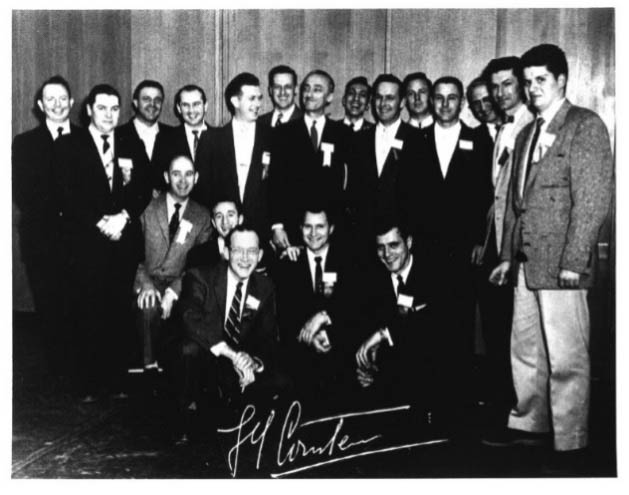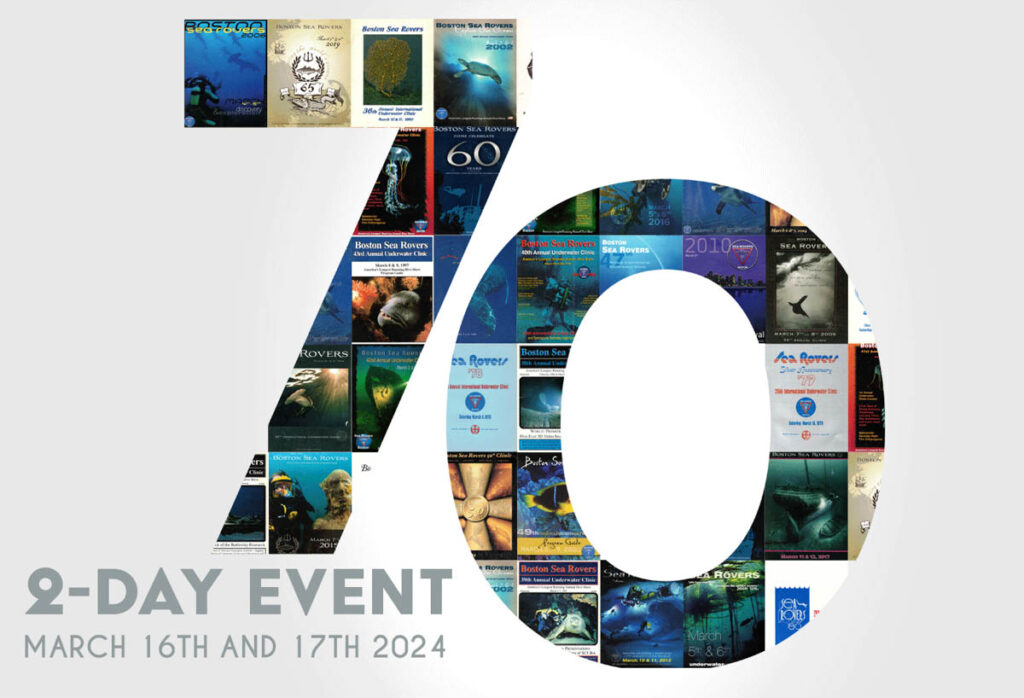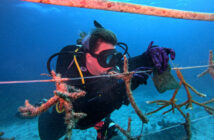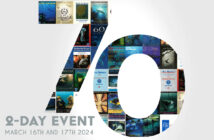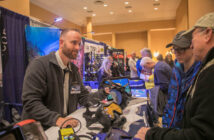The Following is Adapted from a Club History by Board Member Dave Morton
The Boston Sea Rovers are known throughout the world as the Dive Club that can proudly boast ownership of the longest running dive show on Earth, but the Club is much more than that. The Sea Rovers are a group of people from diverse and varied backgrounds who share the common bond of a love for diving, and for the world’s waters, and all its inhabitants. They are divers first, and showmen second. Throughout the seven decades, Sea Rovers have experienced and amassed countless tales and stories from dives and diving events from around the world.
Boston Sea Rovers members and associates include some of the most famous names in underwater exploration including but not limited to: Bob Ballard, Jacque Yves Cousteau, Philippe Cousteau, Sylvia Earle, Harold Edgerton, Martin Klein, Stan Waterman, many more. Sea Rovers have left a legacy of exploration in their wake that includes discovery and documentation of shipwrecks, marine life, antiquities, and geological phenomena as well as the invention of new technologies that have allowed adventurers to travel deeper and farther into the underwater world. The following paragraphs barely begin to scratch the surface of BSR highlights throughout 70 years of exploration.
The Boston Sea Rovers began in the early 1950s when a group of men who were interested in recreational application of early dive technology called the “AquaLung” got together to learn and share ideas. Emile Gagnon and Jacques-Yves Cousteau invented the AquaLung in occupied France in 1943 and made the first dives with the system that summer. WWII kept their invention from reaching the US until the early 1950s. Early adopters in Boston began meeting at the local YMCA in 1953 and advertised their biweekly meeting. By the summer of 1954, the YMCA had received requests at several other pools from people who wanted to try out their equipment. There were no standards, so diver Frank Scalli wrote out a list of do’s and dont’s. The group soon developed a reputation for dive training and instruction.
Diving Pioneer Jacque Yves Cousteau heard about these early meetings. He traveled to Boston in 1955, met with the Boston Sea Rovers, and became a member of the group. The photograph to the right is Cousteau at this 1955 meeting. It is known as the first official Club photo.
The Boston Sea Rovers became a place for luminaries in the field of underwater exploration to meet and learn from one another. Throughout the 1960s, diving science and technology were progressing at a blinding pace, and it seemed like all the important breakthroughs and discoveries throughout the underwater world were introduced first at a Sea Rover Clinic. Dr. George Bond, the scientist who “invented and developed” the concept of saturation diving, first talked to civilians about his fantastic ideas at a Sea Rovers Clinic. Jacques Cousteau first met Dr. Bond in Boston and learned of his saturation diving experiments, an event that changed the world of diving. In a few years, habitat projects such as ConShelf, Man-in-the-Sea, and SeaLab would be front page news – but news that had broken first at a Clinic.
Throughout five decades underwater photographers and cinematographers have premiered more works at Sea Rover Clinics over the years than at any other dive show, and many of these image makers were themselves introduced to the diving public through the Rovers. This description of the 1966 evening show was typical of the events throughout the decade:
“The evening program was at the John Hancock Hall where every seat was occupied and the overflow crowd sat on the steps and stood in the rear. Carlton Ray, just returned from the South Pole, showed movies taken of seals under the ice. Commander Scott Carpenter, Astronaut and Aquanaut, showed movies of his sojourn in Sealab II for 30 days. Captain Walter Mazzone, U.S. Navy, described the physiological problems of Sealab II. Peter Gimbel showed a fascinating twelve-minute shark movie taken in the open sea off Montauk Point, Long Island, NY. Cousteau stayed for the day and evening programs.” Left Gimbel talks with Cousteau after his presentation.
The footage shown by Peter Gimbel would be the spark that began his worldwide journey to document the great white shark, culminating in the classic 1971 film, “Blue Water, White Death.”
In the 1970’s, dive travel was starting to emerge as a hot topic, and most of the newest resort destinations were being premiered and featured at Clinics. Sea Rover audiences traveled around the globe without leaving Boston, as speakers came from all over to introduce us to their fantastic diving, and fascinating marine life.
The diving world experienced one of its greatest growth rates in the 1980s. The continuous evolution of dive gear was hitting the fast lane, and the place to find out about the latest developments was, as always, the Boston Sea Rovers Clinic!
Dive technology saw innovations and advancements throughout the 1990s. This includes everything from developments in submersibles, sonar, and new equipment that allowed divers to explore the depths of the ocean longer than ever before. Many of these technologies – such as mixed gases and closed-circuit rebreathers – were first debuted, debated, and demonstrated at Boston Sea Rovers. By 1993, the 39th Annual Clinic, there was too much going on for just one day and evening film festival, and the show expanded to the full weekend format. This allowed more room for presentations about dive safety, dive medicine, rescue diving, and the physiological consequences of pushing bodies further in pursuit of underwater adventure.
Throughout its 70-year history, underwater storytellers have premiered their footage and films at the Boston Sea Rovers Film Festival, often giving excited audiences first looks at raw footage and photographs. Work debuted at these shows has been published in almost every major magazine and television station including National Geographic, Discovery, History, Smithsonian, etc. Boston Sea Rovers have even served as advisors and cinematographers on Hollywood feature films such as “The Abyss,” “Titanic,” and “Striking Distance.”
Some of the most important underwater shipwreck and archaeological discoveries have been made by Boston Sea Rovers. They include but certainly are not limited to Titanic’s sister ship, HMHS Britannic, the American submarine USS Thresher, RMS Titanic, the German battleship Bismark, the Spanish galleon San Jose, SS North American, and the German submarine U-550. Boston Sea Rovers are responsible for discovering other mysteries of the deep such as thermal vents and new species of marine life. In 1976, Sea Rovers Dr. Harold Edgerton, Emory Kristof, Marty Klein, and Sam Raymond even searched for the Loch Ness Monster!
The Boston Sea Rovers were:
- the first to combine education through entertainment by setting up a Dive Clinic….
- the first to recognize the need for diver training and instruction and to put together a teaching plan for underwater instructors….
- the first to establish a Diver of the Year program to recognize special individuals in the underwater world….
- the first place many of the famous and about to be famous pioneers and innovators in the field of inner space appeared in a public forum….
- the first to premier more films and programs on the underwater world….
- the first to improve the quality of life for a special needs organization by raising funds through diving and divers, thus creating SeaMark, an organization devoted to raising funds for the Cotting School Eye Clinic….
- the first to be on the cutting edge of diving training, medicine, exploration, photography, cinematography, and wreck diving….
The list of “firsts” is endless, the history is full and colorful, and the future is bright and promising. The Boston Sea Rovers, and their Associates, have been seen at the top of the world, at the bottom of the sea, on some of the most famous wrecks in history, in some of the most experimental equipment designed for exploration, and, as always, enjoying the challenges and joys of this underwater world of water.







